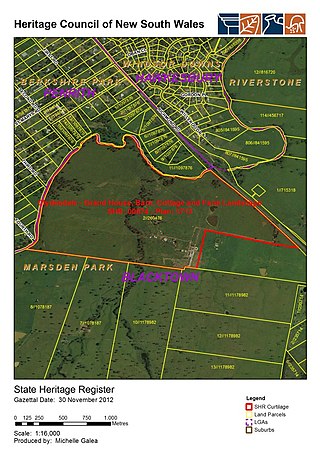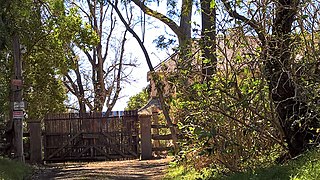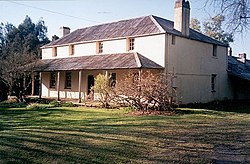
Hobartville is a heritage-listed farm and residence at Kurrajong Road, Richmond, City of Hawkesbury, New South Wales, Australia. It was added to the New South Wales State Heritage Register on 2 April 1999.

Rouse Hill Estate is a heritage-listed homestead and estate off Windsor Road, Rouse Hill, City of Blacktown, New South Wales, Australia. Rouse Hill House and farm was the family home of Richard Rouse, the Colonial Superintendent of Public Works and Convicts at Parramatta.

Clydesdale is a heritage-listed homestead and former seminary and missionary school (1859–71) and wartime hospital (1942–44) at 1270 Richmond Road, Marsden Park, New South Wales, an outer suburb of Sydney, Australia. It was built from 1823 to 1885. It is also known as Lang's Farm; the northern half is also known as Echovale. It was added to the New South Wales State Heritage Register on 2 April 1999.

Rose Cottage is a heritage-listed former cottage and now museum at Rose Street, Wilberforce, City of Hawkesbury, New South Wales, Australia. It was built from 1810 to 1820 by Thomas Rose. The property is owned by the Thomas and Jane Rose Family Society Inc. It was added to the New South Wales State Heritage Register on 2 April 1999.

Macquarie Grove is a heritage-listed former airport administration offices and private residence and now private residence located at Aerodrome Road, Cobbitty, in the south-western Sydney suburb of Camden in the Camden Council local government area of New South Wales, Australia. It was built from 1812 to 1850. The property is privately owned. It was added to the New South Wales State Heritage Register on 2 April 1999.

Government Cottage Archaeological Site is the heritage-listed site of a cottage which served alternately as the base for the Colony of New South Wales' commandant of the Hawkesbury district, house of the district's magistrate and an "informal official residence" for the Governor of New South Wales when in the district. It is located at 41 George Street, Windsor, City of Hawkesbury, New South Wales, Australia. The original house was built from 1796 to 1815 and demolished c. 1920-21. It was also known as Commandant's House and Government House. It was added to the New South Wales State Heritage Register on 4 February 2011.

Macquarie Arms Hotel is a heritage-listed hotel at Thompson Square in Windsor, New South Wales, Australia. It is also known as the Royal Hotel. It was added to the New South Wales State Heritage Register on 2 April 1999.

Bowman House is a heritage-listed former residence and now Hawkesbury Area Office of the National Parks and Wildlife Service at 368-370 Windsor Street, Richmond, New South Wales, an outer suburb of Sydney, Australia. It was built from 1817 to 1820 by James Blackman. It is also known as Bowman's Cottage. It was added to the New South Wales State Heritage Register on 2 April 1999.
Windmill Hill is a heritage-listed former farm and now water catchment area located at Wilton Road in the outer south-western Sydney settlement of Appin in the Wollondilly Shire local government area of New South Wales, Australia. It was built from 1820 to 1950. It is also known as Windmill Hill Group, including Ruins, North Farm, Middle Farm aka Larkin Farm and Windmill Hill, South Farm and Steven's Homestead. The property is owned by Water NSW. It was added to the New South Wales State Heritage Register on 27 June 2014.

Macquarie Arms Inn is a heritage-listed former inn and now residence at 104-106 Bathurst Street, Pitt Town, City of Hawkesbury, New South Wales, Australia. It was also known as the Blighton Arms and Flemings Public House in its time as an inn, while the main house on the property became known as Mulgrave Place. It was added to the New South Wales State Heritage Register on 2 April 1999.

Clear Oaks is a heritage-listed homestead complex at 135 Francis Street, Richmond, New South Wales, an outer suburb of Sydney, Australia. It was built in c. 1809. It is also known as Moxey's Farm House. It was added to the New South Wales State Heritage Register on 2 April 1999.

Richmond Post Office is a heritage-listed former post office at 286 Windsor Street, Richmond, City of Hawkesbury, New South Wales, Australia. It was designed by Colonial Architect James Barnet and built from 1875 to 1888. The original building was built by a Mr. Johnson, with the second-story addition in 1888 added by Samuel Bought. It is also known as Richmond Telegraph and Post Office. It was added to the New South Wales State Heritage Register on 23 June 2000.

Windsor Uniting Church and Hall is a heritage-listed church precinct at Macquarie Street, Windsor, City of Hawkesbury, New South Wales, Australia. The church was built in 1875–76 following the destruction of the original church in a fire, while the Church Hall, which survived the fire, dates from 1861. Originally a Methodist church, it became part of the Uniting Church in Australia following the Methodist Church's amalgamation in 1977. It was added to the New South Wales State Heritage Register on 2 April 1999.

Thompson Square Conservation Area is a heritage-listed precinct centred around Thompson Square in Windsor, City of Hawkesbury, New South Wales, Australia. It was added to the New South Wales State Heritage Register on 2 April 1999.
The North Street residences are a group of individually heritage-listed residences in North Street, Windsor, City of Hawkesbury, New South Wales, Australia. It is also known as the North Street Group. The cottages were added to the New South Wales State Heritage Register on 2 April 1999. They are often grouped with the adjacent former Court House Hotel building. The residence, along with the hotel, had previously been listed both jointly and individually on the former Register of the National Estate on 21 March 1978.

Peninsula House and Tebbutt's Observatory is a heritage-listed residence and former observatory at Palmer Street, Windsor, City of Hawkesbury, New South Wales, Australia. The observatory was built in 1845 by John Tebbutt. It was added to the New South Wales State Heritage Register on 2 April 1999.

St Matthew's Anglican Church is a heritage-listed Anglican church building located at Moses Street, Windsor, City of Hawkesbury, New South Wales, Australia. It was designed by Francis Greenway and built from 1817 by convict labour. The property is owned by the Anglican Church Property Trust. It was added to the New South Wales State Heritage Register on 2 April 1999.

Court House Hotel is a heritage-listed former hotel and now residence at 37–39 North Street, Windsor, City of Hawkesbury, New South Wales, Australia. It was added to the New South Wales State Heritage Register on 2 April 1999. It is often associated with the adjoining North Street residences, some of which shared ownership with the hotel at various times.

St Peter's Anglican Church is a heritage-listed Anglican church and associated Sunday school, rectory, and cemetery at 384 Windsor Street, Richmond, City of Hawkesbury, New South Wales, Australia. It was designed by Francis Clarke and Edmund Blacket and built from 1836 to 1841 by James Atkinson (church). It is also known as St Peter's Anglican Church Group, St Peter's Church Group, Church, Rectory, Church Yard, Cemetery and Stables. It was added to the New South Wales State Heritage Register on 16 August 2019; and on the City of Hawkesbury local government heritage register, and listed on the New South Wales Heritage Database on 12 September 2012.

Hadley Park is a heritage-listed former Aboriginal land, farm, dairy and gravel quarry and now unused building at 14-278 Old Castlereagh Road, Castlereagh, City of Penrith, New South Wales, Australia. It was built from 1803 to 1812. It was added to the New South Wales State Heritage Register on 20 April 2018.






















